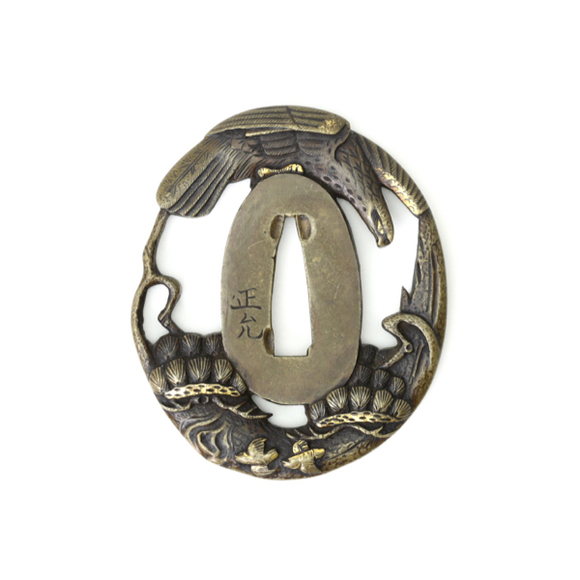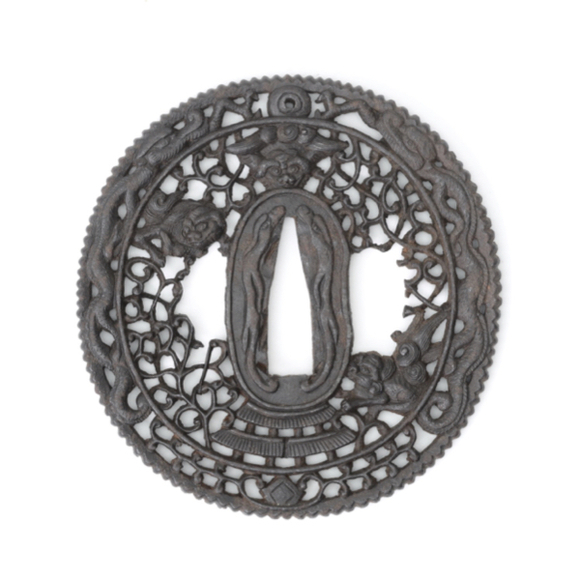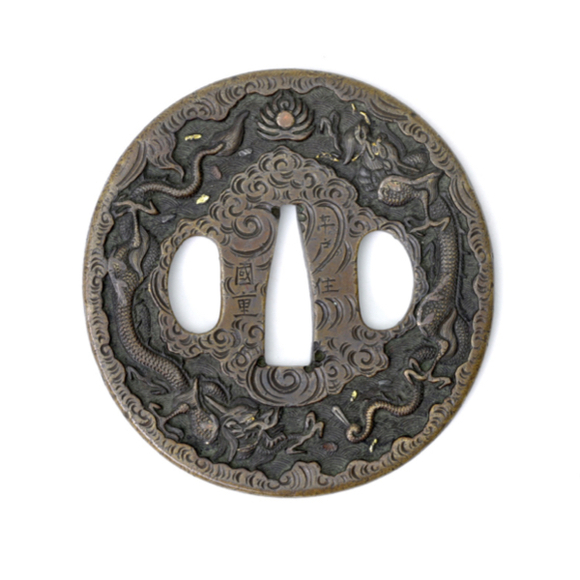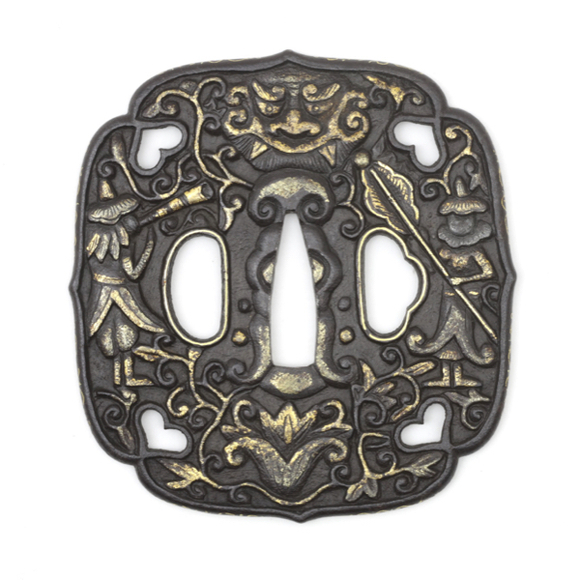Russet iron, one-piece construction with decorative grooves.

75.7 cm
61.2 cm
18 mm
Kasane (base) 7 mm
Kissaki (tip) 5 mm
Kasane (base) 27.5 mm
Kissaki (tip) 20 mm
565 grams
(blade only)
Blade: Tempered steel
Shirasaya: Wood with bone peg
Owari, Japan
Circa 1500 AD
From an American private collection
Introduction
Old records illustrate blades by Kanenobu dated 1482 and 1494.1
Following the fall of the Kamakura shogunate in 1333 AD, many smiths moved to new locations to find employment. Among them was Kaneyoshi, a Yamato Tegai smith who moved to Mino province. His grandson Kaneari founded the Muroya school, which his son, Kanenobu, continued.
Kanenobu then moved to the castle town of Sasaki in Ōmi province, to later settle in Shiga village in Owari, where he founded the Shiga-Seki school. Kanenobu is considered the originator of the Owari Shinto tradition that flourished during the Edo period.2
His blades were rated ō-wazamono for extreme sharpness and jō-saku for superior workmanship.3
Notes to introduction
1. Tenbon Mei Zukushi (天文銘尽) and the Kōsei Kotō Meikan (校正古刀銘鑑). From Markus Sesko; Swordsmiths of Japan. Lulu, Inc. 2014. Page 246.
2. Markus Sesko; Swordsmiths of Japan. Lulu, Inc. 2014. Page 246.
3. The ō-wazamono rating of Kanenobu comes from the Kokon Kajibiko (古今鍛冶備考) or "Ancient and modern blacksmith notes" of 1830. The tests were performed by the 7th head of the Yamada family of test cutters and executioners, Yamada Asaemon Yoshitoshi (山田朝右衛門吉利). Ō-wazamono was the second highest rating a blade could get, under saijō ō Wazamono which only 14 makes achieved. Ō-wazamono meant the blade by this maker cut through a human torso completely 7-8 times out of 10, while it was 8-9 times out of 10 for the highest grade. The jō-saku is a contextual rating by Fujishiro Matsuo in the Nihōn tōkō jiten (日本刀工辞典) of 1961. It means that the maker's work was superior to that of his peers.
Description
A katana by Shiga Seki Kanenobu.
Sword attributes
(With plain English below)
Nakago: O-suriage. Mumei. Kirijiri, kiri yasurime. Two mekugi ana.
(Tang: Shortened. Unsigned. Straight tip and straight file marks. Two peg holes.)
Sugata: Tori-zori. Shinogi-zukuri with slight funbari. Iori-mune.
(Overall form: Curvature concentrated at the center. Blade with ridged sides, ridged spine, and slight taper in width. Spine finished with two facets.)
Jigane: A soft ko itame-hada. Masame in the ji.
(Steel: A subtle small wood grain with straight grain in the upper facet.)
Hamon: A subdued gunome midare in ko-nie-deki with some togari and choji.
(Temperline: A subdued undulating hamon with roundish elements. Small martensite crystals demark the tempered zone, with some pointy and some clove-shaped elements.
Boshi: Ko-maru with long kaeri.
(Temperline at tip: Turning back in a small circle, running fairly along the tip's spine.)
Old shirasaya with sayagaki
It comes in an old, nicely patinated shirasaya of the 20th century. It carries a sayagaki ("writing on scabbard") by Hon'ami Nisshu.
Hon'ami Nisshū (1908–1996) was a sword polisher and sword appraiser of the famous Hon'ami line, a family who used to work directly for the Tokugawa shogunate. He was designated a Living National Treasure by the Japanese government.
He attributed the sword to Tametsugu, the alleged son of Go Yoshihiro, who worked with Go and Norishige in Etchu. Go Yoshihiro was one of Masamune's best students, and Norishige was a peer of Masamune under their common master, Shintogo Kunimitsu.
NBTHK Tokubetsu Hozon papers
The NBTHK attributed this sword to Shiga-Seki Kanenobu, who was active a little over a century later.
The similarity can be attributed to the fact that both were forged in a mix of Sōshū and early Mino style. I err towards the NBTHK opinion here, as the blade lacks the abundant nie and patches of ara nie I am used to seeing on Tametsugu. Its jigane is softer, the forging more tight, and and the hamon more subdued. The increased activity in the upper section blade probably led to Tametsugu, as he was known for this.
What does it mean? In my opinion, a Shiga Seki Kanenobu sword that is mistaken for a Tametsugu by no less than Hon'ami Nisshu is a rather good thing, as Tametsugu was an excellent smith. He, too, was rated jō-saku.
Habaki
Habaki are always custom made for a blade and not easily interchangeable like tsuba and other parts can be. As such they are generally a sign of how highly a previous owner regarded the blade. In this case it has a very high quality gold foil habaki, made of two parts with yasurimei inside in tachi style, with a koke, "moss design" outside casing.
Unusual tsuba with foreign figures and Chinese auspicious symbols.






